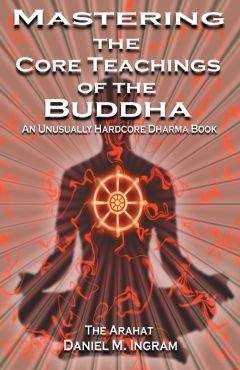Daniel Ingram - Mastering the Core Teachings of Buddha - An Unusually Hardcore Dharma Book
На сайте mybooks.club вы можете бесплатно читать книги онлайн без регистрации, включая Daniel Ingram - Mastering the Core Teachings of Buddha - An Unusually Hardcore Dharma Book. Жанр: Прочее издательство -,. Доступна полная версия книги с кратким содержанием для предварительного ознакомления, аннотацией (предисловием), рецензиями от других читателей и их экспертным мнением.
Кроме того, на сайте mybooks.club вы найдете множество новинок, которые стоит прочитать.

Daniel Ingram - Mastering the Core Teachings of Buddha - An Unusually Hardcore Dharma Book краткое содержание
Mastering the Core Teachings of Buddha - An Unusually Hardcore Dharma Book читать онлайн бесплатно
270
Models of the Stages of Enlightenment However, as the Buddha said, do not imagine that you must
continue to carry the boat once you have crossed the river. While enlightened individuals can at a whim notice the true aspects of sensations, just as color is clear to a person with good eyesight (assuming they are not color-blind), so these things are clear to an enlightened being to various degrees as they progress along the path. That said, just because one can perceive something doesn’t mean that particular aspect is the dominant aspect of consciousness at all times. In short, the Fundamental Perception Models are very useful for practice, but do not quite accurately describe the final result.
THE SPECIFIC PERCEPTION MODELS
Specific Perception Models essentially state or imply that an enlightened being will be constantly hyper-aware of every single sensation that arises in their field of perception, including not just the ultimate aspects of the Fundamental Perception Models, but also every single little detail of the content of those sensations, achieving at all times the perfected fusion of the completely open and panoramic perspective of High Equanimity with the laser-like precision of the Arising and Passing Away at its height. It implies that rather than stopping a process, enlightenment is about becoming so fantastically alert that you see not only the true nature but also the specifics of each and every sensation that arises at all times. This is not even close to what happens in reality. While enlightened beings will cycle through those stages, when mindfulness is low each of those stages will present in a low key way, and only for moments here and there will there be anything like that kind of awareness, though when enlightened beings are on retreat and/or really powering the mindfulness and concentration they can temporarily achieve something that resembles these high ideals.
The Specific Perception Models are another instance where practice instructions get turned into an ideal of what is supposed to happen in exactly the same way as happens with the Fundamental Perception Models. They become one more example of carrying the boat after we have crossed the river. Again, mindfulness comes and goes, sleep comes and goes (though the Tibetan teachings on dream yoga are very intriguing), concentration comes and goes, various perspectives and 271
Models of the Stages of Enlightenment
perceptual thresholds parade through, and the cycles of the ñanas continue on and on.
The ideals in this model and many models that follow it are
sometimes used as a weapon by those who like to criticize those who rightly or wrongly claim to be enlightened. Examples include, “Don’t you remember when I said (such and such)?”, “Didn’t you notice how I cleaned the bathroom?”, or “How could you have forgotten to pay the power bill?” The implication inherent in each of these is that enlightened being should have perfect awareness of all aspects of their sensate reality as well as perfect memory of all of those aspects. This ideal is unfortunately completely bogus. I so wanted to be a Sensation Perceiving Superstar with a photographic memory and have been sorely disappointed. As basically everyone out there has some aspect of this model in their working definition of what “enlightenment” must be, these ideals can be a particular problem in relationships, particularly business relationships and romantic ones for those who are out of the closet about enlightenment.
In this basic vein, this brings up another selling point of realistic, down-to-earth, human models of what awakening brings. If you tell people you are enlightened and also promote very high, idealized, delusional, perfectionistic models of awakening, those who actually get to know well will realize how full of shit you are, particularly people such as spouses or partners, business associated, best friends and the like. Further, the more you get stuck trying to be like the person you dream you are supposed to be rather than who you are, the more you can get isolated in your false and pretentious fantasy land, locked away from the grounding, healing, and helpful reality testing that comes from community and real, intimate human relationships. However, if the Specific Perceptual Models are a problem in this way, you haven’t seen anything until you get to the Emotional Models.
THE EMOTIONAL MODELS
The Emotional Models are so fundamental to the standard ideals of awakening as to be nearly universal in their tyranny. You can’t swing a dead cat in the Great Spiritual Marketplace without hitting them.
Almost every tradition seems to have gone out of its way to promote them in the most absurd and life-denying terms available, though there 272
Models of the Stages of Enlightenment have been attempts at reform also. I must give thanks for the attempts, however ineffective, bizarre, mythologized, cryptic, and vague, that the Tibetan and Zen traditions have occasionally made in this regard, and morn their nearly perpetual failure to make these issues clear. At least they tried, whereas the Theravada basically has really not tried in any significant way in 2,500 years so far as I can tell. If I am wrong, please let me know.
These emotional models basically claim that enlightenment involves some sort of emotional perfection, either gradually or suddenly, and usually make these dreams the primary criteria for their models of awakening and often ignoring or sidelining issues relating to clear perception of the true nature of phenomena. Usually these fantasies involves elimination of the “negative” emotions, particularly greed, hatred, anger, frustration, lust, jealousy, and sadness. At a more fundamental level, they promise the elimination of all forms of attraction and aversion.
As I am sure you can already tell, I am no fan of these models of enlightenment. In fact, I consider their creation and perpetuation to be basically evil in the good old “You Should Burn In Hell For
Perpetuating Them” kind of way, though as guidelines for trying to be kind and behave well (training in morality) I find them of value. I know both what hints of truth they contain and also what a marketing ploy they are, and will attempt to make both aspects clear. This is not easy to do, and the dogma of the Emotional Models is so deeply ingrained in us all that shaking it can be the work of a lifetime even in enlightened beings.
The practical application of making this distinction is based upon the fact that we will try to realize the model we consciously or unconsciously adopt. It is extremely tempting if we buy into the limited emotional range models to go around imitating an emotionally limited state, repressing or ignoring aspects of our basic human nature. There are some benefits to repressing the manifestations of negative emotions while simultaneously being conscious and accepting of the fact that difficult emotions occur. However, if we repress them and also pretend that they don’t exist, this sort of cultivated denial can also produce huge shadow sides and a lot of neurotic behavior.
273
Models of the Stages of Enlightenment
A far more practical approach is to accept that we are human, try to be decent in a normal sort of way rather than in a grandiose spiritual way, and to assume that reducing and eliminating the illusion of the dualistic split is possible through doing basic insight practices. Reducing the sense of a split can provide more clarity, allowing us to be the human beings that we are with more balance and less reactivity in the face of that humanity.
THE THERAVADA FOUR PATH MODEL
The root of the problem in standard Buddhism comes to us from the Theravada Four Path Model. This is the original model presented in the Pali Canon and the oldest model we have to work with. All the subsequent schools (Mahayana of various strains and the Vajrayana) react to it in their way but are still influenced by it even if they say they are not, so you need to know it to understand the debate.
Actually, the problems began long before in ancient Hinduism (which had a huge impact on Buddhism, despite what some Buddhist will tell you) and probably before that, but this is as good a place to start as any. I shouldn’t blame ancient India for what is really a perennial human wish. Let’s face it: we all want emotional perfection, as a large chunk of the pain felt in modern life relates to people’s emotions causing trouble. I will claim that not perceiving our emotions clearly is a far greater problem than the emotions themselves, but I am clearly in the minority in this regard. As I stated in the chapter called Harnessing the Energy of the Defilements, there is a lot to be said for aspects of what we usually consider the bad emotions. It is important to realize that empty compassion underlies all our emotions, whether filtered through the illusion of duality or otherwise.
The Theravada Four Path Model is a model involving four stages of awakening, namely First Path or Stream Entry (Pali: sotapanna), Second Path or Once Returner (sakadagami), Third Path or Never Returner (anagami) and finally Fourth Path, Holy One, Saint, or Conqueror (
arahat, arhat, arahant, or arhant, pick your favorite spelling). The terms Once Returner and Never Returner have to do with issues relating to the dogma that those who have attained to second path cannot be reborn more than once before attaining arahatship, and certainly not in the lower realms (hell realms, hungry ghost realms or animal realms), 274
Models of the Stages of Enlightenment and that those of third path, if they do not attain to arahatship in this lifetime, will at worst be reborn into a heaven realm where the conditions are optimal for achieving enlightenment. However, the core of the Theravada Four Path Model is the dogma that enlightenment involves progressively eliminating the Ten Defilements in the following manner.
Stream Entry eliminates the first three defilements: skeptical doubt, attachment to rites and rituals, and personality belief. Second Path attenuates the fourth and fifth defilements, usually translated as greed and hatred or more technically as attraction and aversion to everything that is not a jhanic state. Third Path is said to eliminate those same fourth and fifth defilements however translated. Fourth Path, that of arahatship, eliminates the remaining five defilements of attachment to formed jhanas (the first four jhanas), attachment to the formless realms (the second four jhanas), restlessness and worry, “conceit” (in quotes because it is a bit hard to translate), and something called “the last veil of unknowing”.
It is important to note that arahats that are said to have “eliminated conceit” (in limited emotional range terms) can appear absolutely arrogant and conceited, as well as restless or worried, etc. That there is no fundamental suffering in them while this is going on is an utterly separate issue. That said, conceit in the conventional sense and the rest of life can cause all sorts of conventional suffering for arahats just as it can for everyone else. While I am on the subject of conceit, perhaps I should take on the subject of the word “ego” in a more comprehensive way than I have done so far.
The pop psychology meaning of the word “ego” is something like arrogance, pride, narcissism, and a failure to take into account the feelings, rights and/or existence of others. This is also the definition that is the most commonly behind such mainstream Buddhist statements as,
“That action or statement that I really didn’t like had a lot of ‘ego’ in it.”
I think that this definition of ego can sometimes be slightly useful for training in morality if we are very kind to ourselves and those around us, but often it seems to me to be pop spirituality turned into a weapon and a form of denial of someone else’s difficulties, feeling and suffering.
275
Models of the Stages of Enlightenment
Worse, people often take this definition, mix it in with their own insecurities and unfortunate fear of existing or asserting themselves in the conventional sense, and then take this neurotic mixture and use it to continue to flog themselves and those around them. Please don’t do this. It is misguided and will not help you or anyone. This pop psychology definition of ego also has nothing to do with enlightenment in the formal sense, and so don’t bring it to mind when you read this chapter except to dismiss it.
Another definition of ego is the formal psychological one put forward by Freud. In this definition, ego is the moderator between the internalized parent or police of the super-ego and the primal drives of the id, those being largely for reproduction and survival. In this sense, ego is an extremely good thing and should be cultivated consciously and without restraint. This definition has to do with the more formal psychological concept of “ego strength,” a strength that is very positive and necessary for the deep and often difficult personal growth that we all want for ourselves. One of the explicit requirements for entering intensive psychoanalysis is high ego strength, the ability to face one’s reality and dark stuff without completely freaking out. Thus, eliminating this form of ego would be a disaster.
For reasons completely beyond me, the word “ego” is also used in a high mystical sense to describe the elimination of the experiential illusion of there being a special reference point as described in the chapter on the Three Characteristics in the section on no-self. One who had eliminated this form of ego, which is in this case a useless illusion, might describe their experience in this way, “In this full field of experience or manifestation, there seems to be no special or permanent spot that is observing, controlling, separated from, or subject to any other point or aspect of the rest of this causal field of experience or manifestation.”
This is the experience and realization of the arahat. Notice that this definition of ego seems to have nothing whatsoever with the other definitions of ego. This is exactly the point, and so I strongly advocate never using the word ego in the context of describing realization or the goal of the spiritual life, or at least not doing so without extensive explanation of this particularly special and uncommon usage of the 276
Models of the Stages of Enlightenment term. Those who do otherwise continue to cause an astounding amount of unrealistic, disempowering and life denying thinking in mainstream Buddhists. It is my sincere wish that the misuse of the word ego and its associated negative side effects stop immediately and forever. Back to the models…
As the Theravada Four Path Model explicitly states that realization is all about eliminating greed, hatred, restlessness, worry, etc., this is as explicitly a limited emotional range model, and, as expected, deserves some serious skepticism. In fact, this is a good time to go into what I love and despise about the Theravada. I absolutely love their emphasis on the Three Characteristics, love the astounding power of their techniques and am grateful beyond words for the maps they provided me for the territory before stream entry, however incomplete and idealized. I am profoundly grateful, at times to the point of tears, and I mean that, for the monasteries I got to sit in, for their preservation of that which is true and useful in Buddhism for 2,500 years, and for the chance to have sat with real, enlightened teachers because of their perseverance and work.
And yet, their maps of enlightenment still contain a hefty helping of scary market-driven propaganda and so much garbage that is life-denying, dangerously out of touch with what happens, and an
Похожие книги на "Mastering the Core Teachings of Buddha - An Unusually Hardcore Dharma Book", Daniel Ingram
Daniel Ingram читать все книги автора по порядку
Daniel Ingram - все книги автора в одном месте читать по порядку полные версии на сайте онлайн библиотеки mybooks.club.




